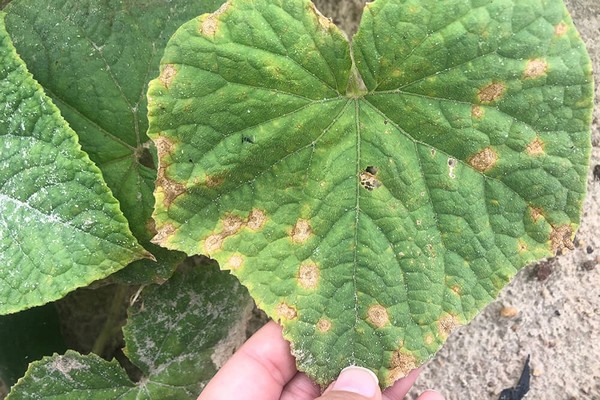Seven East Coast states harvested nearly 102,000 acres of watermelon and cucumber in 2019 and 2020, representing more than 62% ($410 million) and 45% ($180 million) of the U.S. production of the two crops, respectively.
Growers of cucurbits — which include melons, pumpkin, squash, and cucumbers — face numerous challenges in production, leading to decreased profitability and less produce on grocery shelves. Weeds, insect pests, and plant diseases are prominent biotic threats.
Among the plant diseases, one fungus — Colletotrichum spp., which causes anthracnose — is an emerging threat to watermelon and cucumber production on the east coast.
“There is a huge threat from this particular disease,” said Bhabesh Dutta, associate professor in the Department of Plant Pathology at the University of Georgia College of Agricultural and Environmental Sciences (CAES) and a UGA Cooperative Extension vegetable disease specialist. “Growers traditionally have been using Fungicide Resistance Action Committee (FRAC) 11 group of fungicides to manage this disease, but due to fungal populations insensitive to this fungicide, management has been difficult.”

Occurrences of fungicide insensitivity put the long-term viability and profitability of the cucurbit industry at risk, Dutta added.
A multistate effort to rescue an industry at risk
The U.S. Department of Agriculture (USDA) National Institute of Food and Agriculture recently announced that a CAES-led effort is among 21 research and Extension projects included in a $70.2 million Specialty Crop Research Initiative.
The selected research projects address key challenges of national, regional, and multistate importance in sustaining all components of food and agriculture, including conventional and organic food production systems.
In the project “SAM: Sustainable Anthracnose Management for Watermelon and Cucumber Growers in the Eastern U.S., ” project director Dutta and co-project director Marin Brewer, William Terrell Distinguished Professor in the CAES Department of Plant Pathology, will lead a team that will undertake a coordinated, multistate effort to improve the understanding of recent anthracnose outbreaks. The team will work to determine pathogen biology, population structure, host specificity, and fungicide resistance profiles of the pathogen causing severe anthracnose outbreaks in cucurbit crops, including watermelon and cucumber.
Florida, South Carolina, North Carolina, Virginia, Delaware, New York, and the USDA Vegetable Laboratory in Charles, South Carolina, are also included in the four-year, $4.8 million project. Of that amount, $2.2 million will fund research at UGA.
“We have 18 scientists across multiple disciplines and seven Eastern states, along with one USDA-ARS station, participating in the project,” Dutta said. The project will be guided by the stakeholder advisory panel, which includes panels of scientists, seed and chemical industry representatives, cucurbit growers, and state vegetable commissions.
Anthracnose infects all above-ground plant parts and can cause irregular brown spots on leaves and sunken black spots on fruit. While annual yield losses of watermelon and cucumber across the U.S. are difficult to estimate, conservative numbers range from several hundred thousand to millions of dollars, according to a statement to project stakeholders.
The research team will tackle sustainable anthracnose management with two broader goals for the end of the research process: addressing the pathogens by leveraging genomics and plant pathology and developing management practices and breeding efforts to provide a holistic solution for growers.
“One component is fundamental fungal biology and population genetics, and the other is more applied greenhouse and field-based research. At the end of four years, we hope to provide a complete package to our growers that will help them and the cucurbit industry to succeed,” Dutta said.
That arsenal will include practices to reduce disease severity as well as varieties that have resistance to the pathogen. Researchers also aim to discover how the pathogen is introduced and how it survives in diverse geographical locations on the East Coast. They will explore the diversity of the pathogen species complex, whether they are sensitive or resistant to diverse groups of fungicides, and ultimately design tests to detect them.
Beyond tailoring management programs for different conditions from state to state, researchers will be able to help growers detect fungal resistance within a population.
“Knowledge of fungicide sensitivity or resistance status of Colletotrichum spp. in different geographical areas will help growers to make informed decisions on their choice of fungicide program,” Dutta said.
Creating a sustainable production system for cucurbits — and beyond
Each component of the SAM research project will impact the general and sustainable production of watermelon and cucumber in the region. Management strategies resulting from the project will reduce losses to anthracnose across the production chain, maximizing productivity and profitability. This is especially critical in rural agricultural communities where cucurbit crops are an essential aspect of the local economy.
Beyond economic benefits, optimized production practices and precise fungicide use will minimize the overuse of fungicides and losses to anthracnose and increase the efficient use of land, water, fuel, pesticides, and other resources for cucurbit production. Ultimately, the integration of host resistance in integrated pest management for anthracnose will reduce the cost of production for growers and foster improved environmental stewardship.
While cucurbit growers will collaborate with researchers, Extension, and private industry professionals to manage this pressing issue, the project will train future agricultural scientists, including graduate students and postdoctoral researchers.
“I’m excited by the challenge. It’s a challenging project with a challenging organism, and you may have to rely on a multifaceted approach to manage it,” Dutta said. “In any scientific project, if you answer one question, it will open many new questions. The answers we learn from this particular project will also help in devising strategies against similar organisms in different systems.”
Source: caes.uga.edu
